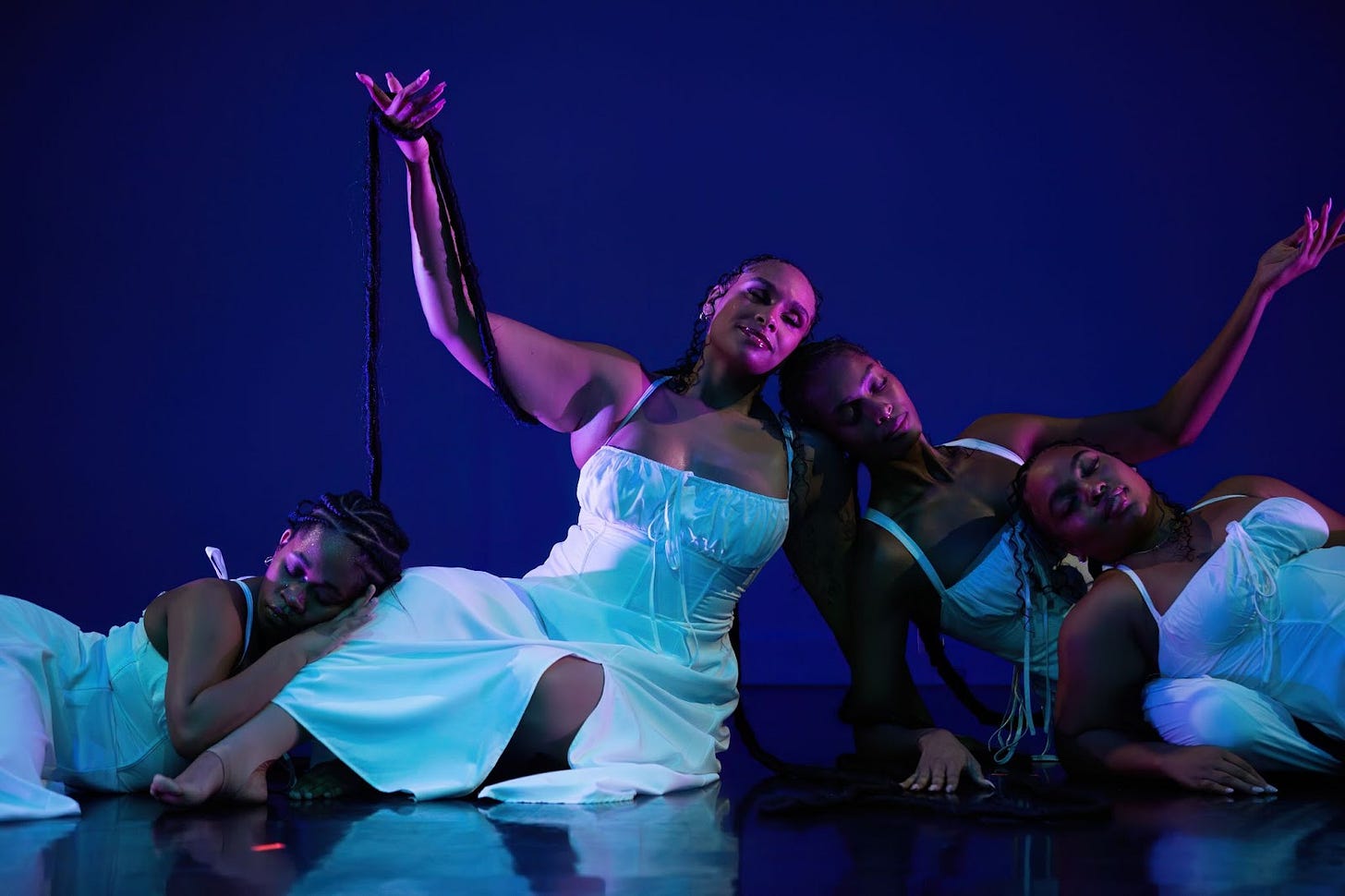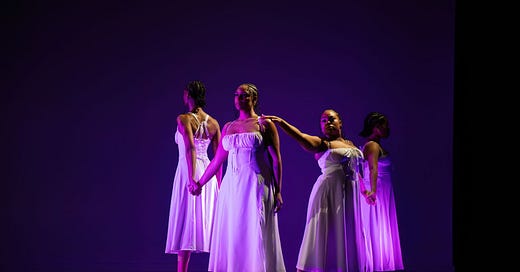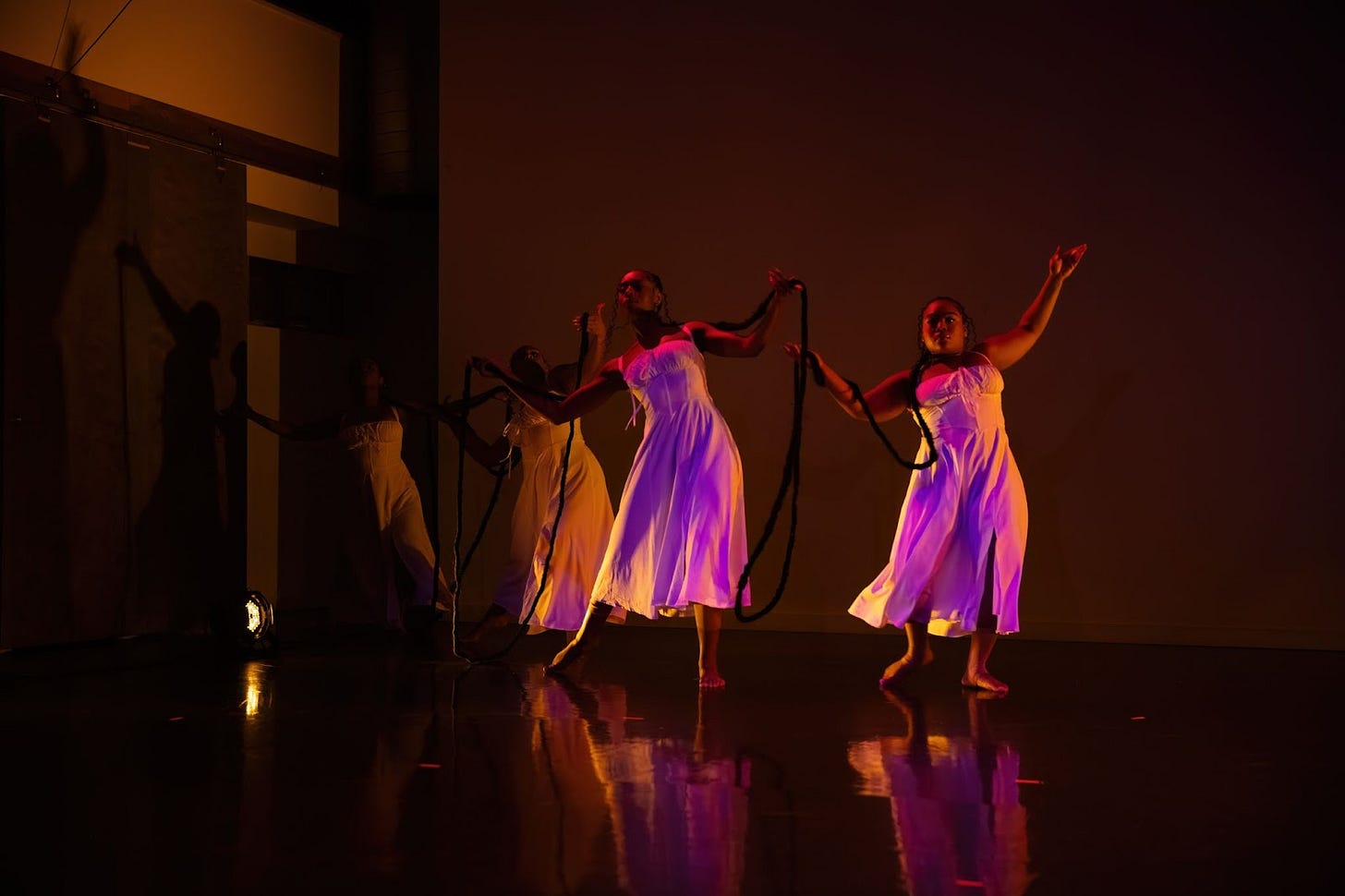If passed, the CROWN Act, founded by Dove, the National Urban League, Color Of Change, and Western Center on Law & Poverty, would “prohibit race-based hair discrimination, which is the denial of employment and educational opportunities because of hair texture or protective hairstyles including braids, locs, twists, or bantu knots.” It is the first legislation at the state level in the United States to protect Black and brown bodies against discrimination. The acronym C.R.O.W.N stands for Create a Respectful and Open World for Natural Hair, a mission that Freshworks artist and choreographer Arnita Simone personally and professionally embarked on during her creative residency at Kelly Strayhorn Theater.
Simone’s piece, Heavy is the Crown, explored themes of identity, migration, and craft in a beautifully woven contemporary dance performance at Kelly Strayhorn’s Alloy Studios. Though race-based hairstyles are often derided and discriminated against in mass media, public schools, and work spaces, Black hair designs have a centuries-long history that originated among Indigenous and enslaved populations. Simone researched, studied, and honored this tradition in Heavy Is The Crown by recreating the physical techniques of braids, locs, twists, and knots in the medium of movement.
The tiered, woven technical forms of Heavy is the Crown evoked a hairstyle, with strands of recorded interviews threading into contemporary music and suggesting an overall look or expectation of the subsequent dance piece. Each segment included a prologue of documented dialogue projected on the Alloy Studios back wall. Lines of italicized white text against a black background spoke to cultural heritage and legacy inspired by the ensemble’s own migrational and artistic identities. Whereas in the post-show talk back with fellow dancers Amani Hill, Marissa Lily, and Naijah Simon, Simone shared that she initially wanted to integrate historic citations and voiceovers, she ultimately decided after a conversation with her fellow dancers to showcase their words instead.
Marissa Lily’s own lived experience of being publicly harassed through daily derogatory slurs while at the American Musical Dramatic Academy in New York City featured predominantly in the piece, introducing the unspoken but overt prejudice and discrimination faced by Black women. Her story built to a powerful medley of “Ghost” by Beyoncé and “Strange Fruit” by Nina Simone, in which the dancers metabolized physical attacks to their personhood through their bodies—each one ultimately consumed and dragged off the stage by an insidious and invisible force.
Heavy is the Crown investigated the relationship between self and society as a site of negotiation. By utilizing the vernacular of hairstyling to reclaim experiences and contemporary issues around prejudice, both the personal and political, specifically the CROWN Act, Simone’s practice existed at the intersection of nostalgia, race, and identity.
Murmurs and sounds of empathy or encouragement emanated from the audience listening to those verbal testimonies on the psyche, and seeing them play out in the speakers’ physiques. Every choreographed collective movement drew attention to the physical Black female body and hairstyles that continue to be significant communicators on wealth, power, ethnicity, social status, and religion. Additionally, hair “movements,” both from the 1960s and 2010s, were represented by a dance sequence with a large-scale strand of hair. This singular loc bound the ensemble together—each one tethered to each other’s low buns so they remained connected as they knelt and rose to “Woman” by Doja Cat . The twist stayed wrapped around their arms and suspended from their wrists, as Simone, Hill, Lily, and Simon, wove their bodies around each other. The movements differed from dancer to dancer despite the identical white dresses and hairstyles, showcasing their individual strengths and diverse perspectives while celebrating their shared African American lineage.
One of the final movements in Heavy is the Crown is a hype-up of the dancers and members of the audience alike. Each performer took center stage posing in an acknowledgement of their strength and beauty to then pass on their self-empowerment and admiration to a family member, loved one, or friend in the crowd through air hearts, pointed fingers, fanned hands at flushed faces to signal hotness, blown kisses, and an overall honoring of the seated and dancing female Black body. The personalized act of engagement with gathered ancestors, family, and community was befitting of Kelly Strayhorn Theater’s opening remarks to audiences: “Welcome home.”

If KST’s Freshworks program is an open invitation to experiment and develop, then its strength and charisma rests on its homeyness: heartfelt and personal. With the support of this artistic residence, Arnita Simone fearlessly explored the sovereignty of Black hair, pulling out and up from her core the physical labor of female bodies who carry this crown—weaving dance and testimony with the divine beauty and freedom of Black creativity.





